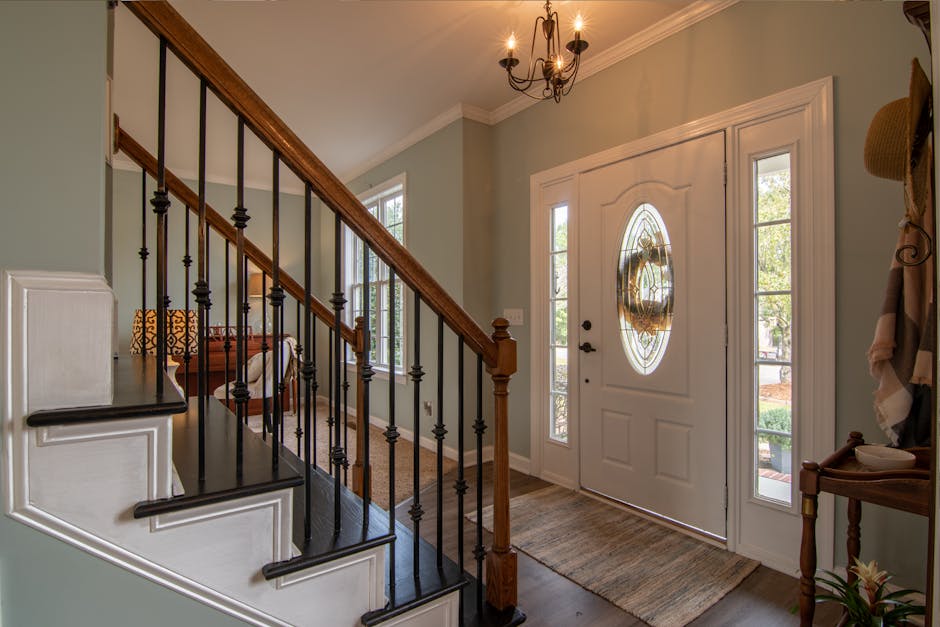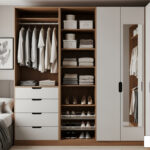Entryway Design: 8 Genius Tips for a Stunning Home
Why Entryway Design Is Your Home’s Most Powerful First Impression
Entryway design is about creating a functional, welcoming space that sets the tone for your entire home. For guests, it’s their first glimpse into your style, and for you, it’s the first and last space you see daily. Key elements include:
- Landing Strip: A surface for keys and mail.
- Seating: A bench or stool for putting on shoes.
- Storage: Hooks or shelves for coats and bags.
- Lighting: Bright, welcoming illumination.
- Mirror: For last-minute checks and reflecting light.
The challenge is that most of us have narrow hallways or doors that open straight into a living room, where every inch matters. The good news? You don’t need a grand foyer to create an entryway that works hard and looks great. With smart furniture, clever storage, and a few design tricks, even the tiniest entrance can become organized and stylish.
I’m Ramy Saber, founder of Tiny Living Genius. With my background in engineering and space optimization, I’ve helped countless people master entryway design in compact homes. This guide offers practical solutions that blend style with function, perfect for small-space living.

The Foundations of a Successful Entryway Design
A successful entryway design balances beauty with practicality. It should be the opening act of your home’s story, working as hard as it looks good. Here’s how to build a strong foundation.
1. Start with Functionality
Function always comes first. An entryway must smooth out your daily routines. Start by establishing a “drop zone”—a designated spot for keys, mail, and bags to land. This can be a small shelf, a bowl on a console, or a wall organizer. Next, add seating for putting on shoes; a bench or stool is a game-changer for morning rushes. Storage for coats and bags is also non-negotiable, using hooks, a hall tree, or a closet.
Finally, consider easy-to-clean surfaces. Your entryway endures dirt and moisture, so choose durable flooring like porcelain tile or luxury vinyl tile (LVT). A washable runner can also protect floors while adding color.
2. Set the Mood with Style
With function covered, it’s time to add personality. Your entryway should reflect your home’s style and create a welcoming atmosphere.
- Create a Focal Point: Catch the eye with a striking mirror, a piece of art, or a unique console table. This makes the space feel intentional.
- Choose a Color Palette: Pull colors from your home’s overall scheme for a cohesive flow. A brightly painted front door can also make a bold first impression.
- Layer Your Lighting: A well-lit entryway feels warm and inviting. Combine overhead lighting for general illumination with task lighting over your drop zone to create depth and ambiance.
- Ensure Smooth Traffic Flow: Arrange furniture to guide people in and out without creating bottlenecks, especially in small spaces.
For more insights on making every inch of your compact home work harder, check out our guide on Efficient Design for Small Spaces: Stylish Living Solutions.
Smart Ideas for Small Entryways

Many of us have small entryways—a narrow hall, a tiny corner, or a door opening directly into the living room. But small doesn’t mean sacrificing style or function. The secret to a great small entryway design is being intentional. Every item must have a purpose, and ideally, more than one.
3. Maximize Space with Multi-Use Furniture
When floor space is precious, multi-use furniture is your best friend. These pieces provide multiple functions in a single footprint.
- Storage Benches: These offer a spot to sit plus hidden storage for shoes, bags, or winter gear.
- Slim Console Tables: A console with a narrow profile (10-12 inches deep) provides a landing strip and drawer storage without crowding the space.
- Ottomans with Hidden Storage: A versatile option for seating and concealed storage that can be easily moved.
- Foldable Seating: A wall-mounted fold-down stool provides seating only when you need it, keeping the entryway clear.
For more innovative furniture solutions, check out our guide on Creative Ideas for Small Space Furniture: Maximizing Functionality.
4. Implement Genius Storage Solutions
A functional entryway needs a designated home for everything. The golden rule for small spaces is to think vertically.

- Go Vertical: Use your wall space. Floating shelves create landing spots without taking up floor space. Wall-mounted hooks or a slim coat rack are far better than a bulky freestanding one.
- Conceal Shoes: Slim, wall-mounted shoe cabinets are perfect for narrow hallways, keeping footwear organized and off the floor.
- Use Baskets and Trays: These hardworking organizers corral umbrellas, bags, and mail. A simple tray on a console keeps keys and wallets contained.
For more storage ideas, visit our page on Smart Storage Solutions for Small Spaces.
5. Use Decor to Create an Illusion of Space
Smart decor choices can trick the eye and make an entryway feel larger than it is.
- Mirrors are Magic: A large mirror reflects light and views, instantly making the space feel bigger. Position it across from a light source to maximize the effect.
- Use Light Paint Colors: White, soft gray, or pale blue walls create an airy, open feeling. Add warmth with wood tones and textiles.
- Add a Runner Rug: A long runner rug introduces color and pattern while visually lengthening a narrow hallway.
- Layer Lighting: Combine overhead fixtures, wall sconces, and a small table lamp to create depth and a welcoming glow.
- Accept Minimalist Decor: In a small entryway, less is more. A few carefully chosen statement pieces look better than a cluttered collection.
For more guidance, explore our tips on choosing furniture for small spaces effectively.
Personalizing Your Entryway from Floor to Ceiling

Your entryway design is more than just storage; it’s a chance to express your personality. This is the space that greets you and your guests, so it deserves to reflect your unique style.
6. Make a Statement That Reflects Your Style
A small entryway is the perfect canvas for bold statements. Consider these ideas:
- Paint the Front Door: A vibrant, unexpected color is an easy way to inject personality.
- Upgrade Hardware: Unique doorknobs, kick plates, or knockers add character.
- Use Bold Wallpaper: A small space is ideal for experimenting with dramatic prints or patterns. Explore bold wallpaper prints to find a style that speaks to you.
- Display Art: A large statement piece or a curated gallery wall of photos and mementos tells your story.
- Add Meaningful Objects: Vintage finds or travel souvenirs add layers of personality that store-bought decor can’t replicate.
7. Incorporate Popular Entryway Design Trends
Sprinkle in current trends to keep your space feeling fresh. Choose ones that resonate with your personal style.
- Natural Elements: Materials like rattan, woven textiles, and wood bring warmth and an earthy feel.
- Arched Mirrors: The soft curve adds an architectural detail that is both classic and contemporary, while making the space feel larger.
- Color Drenching: Painting walls, trim, and the ceiling in a single, immersive color creates a bold, cohesive look. Find earthy paint colors to set the mood.
- Vintage and Antique Pieces: An antique console or weathered mirror adds history and charm.
- Biophilic Design: Houseplants bring life and freshness to your entrance, creating a calm, welcoming vibe.
8. Create a Mini-Mudroom for Maximum Utility
For many, the entryway is a hardworking command center. You can create a mini-mudroom to handle the daily chaos, even in a small space.
- Define the Zone: Use a durable rug to signal where the outside world stops.
- Choose Durable Flooring: Porcelain tile and luxury vinyl tile (LVT) are tough, easy-to-clean options. A washable runner also works well.
- Add Smart Seating: Benches with built-in cubbies provide seating and individual storage for each family member.
- Use Wall Hooks: Go vertical with hooks for coats and bags to keep the floor clear.
- Contain the Mess: A simple boot tray contains mud and water from wet shoes, protecting your floors.
For more practical furniture solutions, check out The Ultimate Guide to Small Apartment Furniture: Smart Solutions for Tiny Living.
Frequently Asked Questions about Entryway Design
Here are our answers to the most common questions about making your entryway design work beautifully, no matter the challenge.
What are the absolute must-haves for a small entryway design?
For a small entryway design, focus on these four essentials:
- A landing strip: A small floating shelf or narrow console table to drop keys and mail.
- Hooks for keys and coats: Wall-mounted hooks save precious floor space and keep outerwear organized.
- A mirror: It’s practical for last-minute checks and reflects light, making the space feel larger and brighter.
- Good task lighting: A well-lit entryway is welcoming and functional. Use an overhead fixture, sconces, or a small lamp.
How can I create an entryway if my door opens directly into the living room?
If your door opens into a living room, you can still define an entryway without renovations. Try these tricks:
- Use a durable rug: A rug visually carves out an “entryway” zone.
- Place a narrow console table: Position it against a nearby wall or behind your sofa to create a landing strip.
- Add a divider: A decorative screen or an open bookshelf can create a subtle boundary and add storage.
- Create a wall “vignette”: Group a mirror, shelf, and hooks on the wall near the door to create a functional entryway moment.
What is the best flooring for a high-traffic entryway?
Your entryway needs durable flooring that can handle high traffic and moisture. Our top recommendations are:
- Porcelain tile: Extremely durable, hard, and resistant to scratches, stains, and water. It comes in a huge variety of styles.
- Luxury vinyl tile (LVT): Offers impressive water resistance and durability with realistic wood or stone looks. It’s warmer and softer underfoot than tile.
- A durable, washable runner rug: This protects existing floors while adding color, pattern, and personality. Look for materials that can withstand heavy use.
Conclusion
We’ve covered the essentials of entryway design, from functional basics to creative tricks for small spaces. Any entryway, regardless of size, can be both beautiful and functional without a large budget or renovation.
Start with the principles we’ve discussed: establish a drop zone, add seating and storage, use vertical space, and incorporate good lighting and a mirror. From there, let your personality take over with color, art, and personal touches. Whether you need a stylish statement or a hardworking mini-mudroom, you can create an entrance that works for you.
At Tiny Living Genius, we believe smart design makes a big impact in compact spaces. Your entryway is the perfect place to start. With multi-use furniture, clever storage, and thoughtful decor, you can transform your entrance into a space that works hard, looks great, and welcomes you home every day.
Ready to tackle the rest of your compact home? Explore more tiny apartment tips and tricks and learn how to maximize every inch of your space with style and function.



